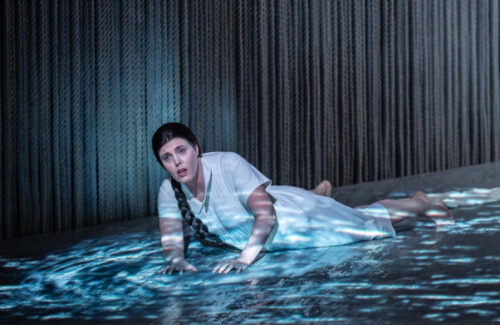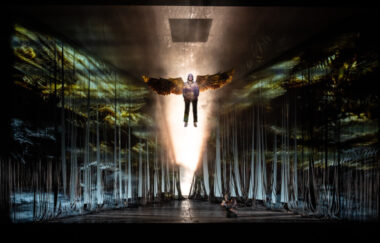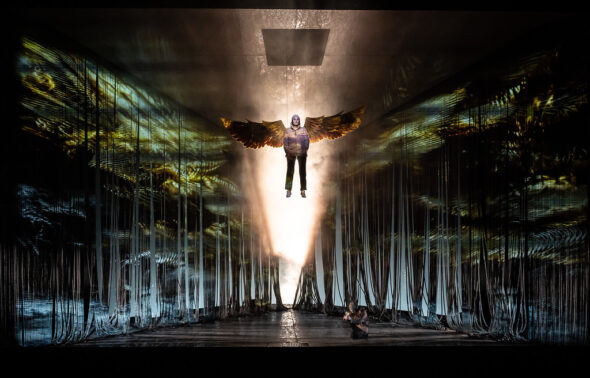 United Kingdom Górecki, Symphony of Sorrowful Songs (Symphony No.3, Op.36, 1976): Nicole Chevalier (soprano), Orchestra of English National Opera / Lidiya Yankovskaya (conductor). London Coliseum, St Martin’s Lane, London, 3.5.2023. (CC)
United Kingdom Górecki, Symphony of Sorrowful Songs (Symphony No.3, Op.36, 1976): Nicole Chevalier (soprano), Orchestra of English National Opera / Lidiya Yankovskaya (conductor). London Coliseum, St Martin’s Lane, London, 3.5.2023. (CC)

Production:
Director / Set and Costume designer – Isabella Bywater
Lighting designer – Jon Driscoll
Video designer – Roberto Vitalini
Movement director – Dan O’Neill
English National Opera has staged its fair share of works not originally intended for the theatre, including the St John Passion of Bach. Now it is the turn of Henryk Górecki’s Third Symphony, which in staged performance was labelled by its subtitle, ‘Symphony of Sorrowful Songs’. It was sung in Polish, in a departure from ENO’s usual English translation (but, again, they have upheld, say Sanskrit in the Philip Glass opera Satyagraha).
Górecki’s score hardly lends itself to dramatic action, and Isabella Bywater is right to refer to her staging as ‘almost an installation’. It is an effective one, though – ENO’s vast stage is delimited into a wedge space by what initially looks like walls but later turns out to be ropes through which one may pass. In the first movement, a mother mourns the death of her son’; in the second, a young woman waits for, and prepares for, death, singing a plea to the Divine Mother of God; a third woman (all are played by Nicole Chevalier) wanders around a post-conflict wilderness, searching for her lost son amongst the dead bodies.
The central movement is a setting of a prayer on a wall in a Gestapo prison in Zakopane; the first is a Lamentation of the Holy Cross Monastery from the ‘Lysagóra Songs’ collection of the fifteenth century; the final song is a folksong in the dialect of the Opole region.
We feel the grief of the protagonist in the opening, an extended, trudging, seemingly never-ending setting by Górecki for strings. Lidiya Yankovskaya paced the piece perfectly as Nicole Chevalier sat in the position of what looks like a pietà, with a body on a suspended board between Heaven and Earth; there is a projection of a forest around. Unnamed figures writhe. Górecki’s haunting lines, punctuated now by single piano tones, is plaintive and poignant; and Chevalier sounded superb, projecting beautifully. Gathering the clothes of the deceased, Chevalier creates what looks like a baby to be cradled. Chevalier is herself suspended later, swooping down in a gravity-defying move like an airborne spirit.
In the second panel of the work, shady, hooded figures stalk the stage, eventually dragging her away. The movement begins with a remarkably Britten-ish harmonic progression, repeated in an almost ritualistic fashion before the voice enters, to low strings metaphorically dragging her down to the earth. All three movements are marked Lento; two of the indicators include the work ‘cantabile’ while the central panel moves to a ’tranquilissimo’. The dark setting on stage, the use of the soprano’s lower registers – all suggest a liminal space. Although also based on repeated figures, the mood of the central movement is different; that opening gesture, when it returns, is like sunlight through a window into a dark, dusty church. Chevalier’s way with the slowly-unfolding line was incredibly touching – she is a marvellous artist from all angles. The way she can hold the stage, too, was positively mesmerising.

The images of war in the final movement are all very close to home these days, of course. The idea of someone searching a battlefield for a fallen son is no longer an image that one might relegate to fiction only, and so this portion resonated even more deeply. Those single piano notes return against shifting strings. The protagonist rises, bewinged like an angel – although the wings are curiously horizontal, like the Luftwaffe pilots’ ’wings’ sewn on their uniforms. Could that have been a deliberate reference? Here, the marking is Lento – Cantabile semplice, and both Chevalier and Yankovskaya found just the right pace and mode of utterance – a slow procession that was also a timbral ascent, with the sound becoming ever more radiant.
It is a fine staging, beautifully lit by Jon Driscoll; the video projections (Roberto Vitalini) are perfectly judged and executed.
The performance was preceded by an unannounced performance of three lullabies (Dawn, Twilight, Midnight) by members of the laudable ENO Breathe, Jack Ross and Hazel Gould, plus a selection of speeches.
A memorable evening. The ENO orchestra are on fire at the moment they were, too, in the performance of Blue (review click here) just a few days previously, too.
Colin Clarke
